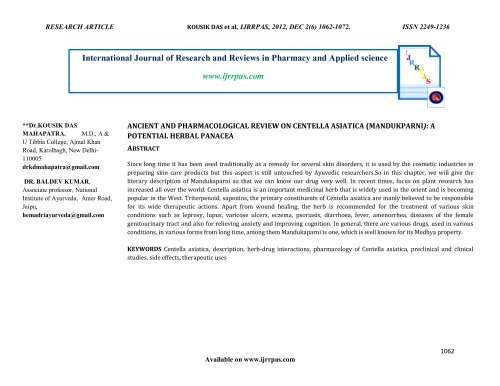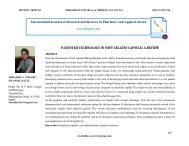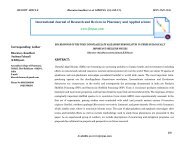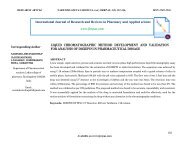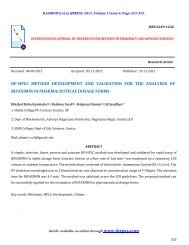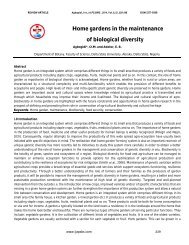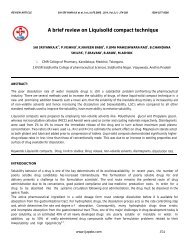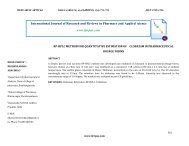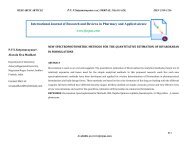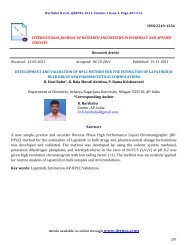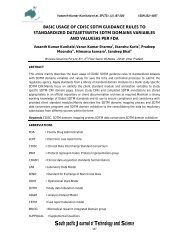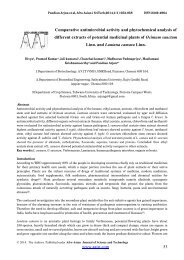Ancient-and-pharmacological-review-on-centella-asiatica-mandukparni-a-Potential-herbal-panacea
Ancient-and-pharmacological-review-on-centella-asiatica-mandukparni-a-Potential-herbal-panacea
Ancient-and-pharmacological-review-on-centella-asiatica-mandukparni-a-Potential-herbal-panacea
You also want an ePaper? Increase the reach of your titles
YUMPU automatically turns print PDFs into web optimized ePapers that Google loves.
RESEARCH ARTICLE KOUSIK DAS et al, IJRRPAS, 2012, DEC 2(6) 1062-1072, ISSN 2249-1236<br />
Internati<strong>on</strong>al Journal of Research <str<strong>on</strong>g>and</str<strong>on</strong>g> Reviews in Pharmacy <str<strong>on</strong>g>and</str<strong>on</strong>g> Applied science<br />
www.ijrrpas.com<br />
**Dr.KOUSIK DAS<br />
MAHAPATRA. M.D., A &<br />
U Tibbia College, Ajmal Khan<br />
Road, Karolbagh, New Delhi-<br />
110005<br />
drkdmahapatra@gmail.com<br />
DR. BALDEV KUMAR,<br />
Associate professor, Nati<strong>on</strong>al<br />
Institute of Ayurveda, Amer Road,<br />
Jaipu,<br />
hemadriayurveda@gmail.com<br />
ANCIENT AND PHARMACOLOGICAL REVIEW ON CENTELLA ASIATICA (MANDUKPARNI): A<br />
POTENTIAL HERBAL PANACEA<br />
ABSTRACT<br />
Since l<strong>on</strong>g time it has been used traditi<strong>on</strong>ally as a remedy for several skin disorders, it is used by the cosmetic industries in<br />
preparing skin care products but this aspect is still untouched by Ayuvedic researchers.So in this chapter, we will give the<br />
literary descripti<strong>on</strong> of M<str<strong>on</strong>g>and</str<strong>on</strong>g>ukaparni so that we can know our drug very well. In recent times, focus <strong>on</strong> plant research has<br />
increased all over the world. Centella <strong>asiatica</strong> is an important medicinal herb that is widely used in the orient <str<strong>on</strong>g>and</str<strong>on</strong>g> is becoming<br />
popular in the West. Triterpenoid, sap<strong>on</strong>ins, the primary c<strong>on</strong>stituents of Centella <strong>asiatica</strong> are manly believed to be resp<strong>on</strong>sible<br />
for its wide therapeutic acti<strong>on</strong>s. Apart from wound healing, the herb is recommended for the treatment of various skin<br />
c<strong>on</strong>diti<strong>on</strong>s such as leprosy, lupus, varicose ulcers, eczema, psoriasis, diarrhoea, fever, amenorrhea, diseases of the female<br />
genitourinary tract <str<strong>on</strong>g>and</str<strong>on</strong>g> also for relieving anxiety <str<strong>on</strong>g>and</str<strong>on</strong>g> improving cogniti<strong>on</strong>. In general, there are various drugs, used in various<br />
c<strong>on</strong>diti<strong>on</strong>s, in various forms from l<strong>on</strong>g time, am<strong>on</strong>g them M<str<strong>on</strong>g>and</str<strong>on</strong>g>ukaparni is <strong>on</strong>e, which is well known for its Medhya property.<br />
KEYWORDS Centella <strong>asiatica</strong>, descripti<strong>on</strong>, herb-drug interacti<strong>on</strong>s, pharmacology of Centella <strong>asiatica</strong>, preclinical <str<strong>on</strong>g>and</str<strong>on</strong>g> clinical<br />
studies, side effects, therapeutic uses<br />
Available <strong>on</strong> www.ijrrpas.com<br />
1062
RESEARCH ARTICLE KOUSIK DAS et al, IJRRPAS, 2012, DEC 2(6) 1062-1072, ISSN 2249-1236<br />
INTRODUCTION<br />
Plants have been used as treatments for thous<str<strong>on</strong>g>and</str<strong>on</strong>g>s of years, based <strong>on</strong> experience <str<strong>on</strong>g>and</str<strong>on</strong>g> folk remedies <str<strong>on</strong>g>and</str<strong>on</strong>g> c<strong>on</strong>tinue to draw wide attenti<strong>on</strong> for their role in<br />
the treatment of mild <str<strong>on</strong>g>and</str<strong>on</strong>g> chr<strong>on</strong>ic diseases. In recent times, focus <strong>on</strong> plant research has increased all over the world <str<strong>on</strong>g>and</str<strong>on</strong>g> a large body of evidence has<br />
been accumulated to highlight the immense potential of medicinal plants used in various traditi<strong>on</strong>al systems of medicine. Centella <strong>asiatica</strong> (CA) is a very<br />
important medicinal herb used in the orient, which is also becoming popular in the West. Comm<strong>on</strong>ly known as m<str<strong>on</strong>g>and</str<strong>on</strong>g>ukparni or Indian pennywort or<br />
jalbrahmi, it has been used as a medicine in the Ayurvedic traditi<strong>on</strong> of India for thous<str<strong>on</strong>g>and</str<strong>on</strong>g>s of years <str<strong>on</strong>g>and</str<strong>on</strong>g> listed in the historic ‘Sushruta Samhita’, an<br />
ancient Indian medical textThe herb is also used by the people of Java <str<strong>on</strong>g>and</str<strong>on</strong>g> other Ind<strong>on</strong>esian isl<str<strong>on</strong>g>and</str<strong>on</strong>g>s. In China, known as gotu kola, it is <strong>on</strong>e of the<br />
reported “miracle elixirs of life” known over 2000 years ago. CA or gotu kola should not be c<strong>on</strong>fused with kola nut as it does not c<strong>on</strong>tain any caffeine <str<strong>on</strong>g>and</str<strong>on</strong>g><br />
has not been shown to have stimulant properties. In the nineteenth century, CA <str<strong>on</strong>g>and</str<strong>on</strong>g> its extracts were incorporated into the Indian pharmacopoeia,<br />
wherein in additi<strong>on</strong> to wound healing, it was recommended for the treatment of various skin c<strong>on</strong>diti<strong>on</strong>s such as leprosy, lupus, varicose ulcers, eczema,<br />
psoriasis, diarrhoea, fever, amenorrhea, <str<strong>on</strong>g>and</str<strong>on</strong>g> diseases of the female genitourinary tract.<br />
1. ABOUT CANTELLA<br />
Historical <str<strong>on</strong>g>review</str<strong>on</strong>g><br />
Original dimensi<strong>on</strong>s of Ayurveda are in built in the ancient compendia of Indian wisdom called Vedas, which are believed to be documented around<br />
6000 years back. So to make this study more informative, authentic <str<strong>on</strong>g>and</str<strong>on</strong>g> interesting let us look into the past <str<strong>on</strong>g>and</str<strong>on</strong>g> begin with VEDAS. In vedic literature,<br />
we may find the extensive descripti<strong>on</strong> of M<str<strong>on</strong>g>and</str<strong>on</strong>g>ukaparni in Atharvaveda.In Matsaya purana, M<str<strong>on</strong>g>and</str<strong>on</strong>g>ukaparni is menti<strong>on</strong>ed am<strong>on</strong>g the medicinal plants<br />
that beneficial for brain. In Agnipurana, it is placed with the plants that are used as sterilizers i.e. pois<strong>on</strong> killers (Ag.Pu.222.7,8,9) <str<strong>on</strong>g>and</str<strong>on</strong>g> for curing<br />
Kamla(Ag.Pu.300.34). Besides these it is also used in Churna form with milk as Anupana to rule out Valli, Palit (Ag.Pu.286.5).Am<strong>on</strong>g the eight<br />
brahmanas, M<str<strong>on</strong>g>and</str<strong>on</strong>g>ukparni is described in Shathpathbrahmana.In Kaushiksutra, it is described as an Aushadhi that resembles m<str<strong>on</strong>g>and</str<strong>on</strong>g>uka.<br />
Am<strong>on</strong>g the existing old medical treatise of India, ‘Charaka Samhita’ can be c<strong>on</strong>sidered as the oldest. The whole book is divided into eight parts. In which<br />
a large number of medicinal plants are described including their different classificati<strong>on</strong> <str<strong>on</strong>g>and</str<strong>on</strong>g> rati<strong>on</strong>al administrati<strong>on</strong> in different kinds of diseases in<br />
various forms. A few regarding M<str<strong>on</strong>g>and</str<strong>on</strong>g>ukaparni are tabled below:<br />
Available <strong>on</strong> www.ijrrpas.com<br />
1063
RESEARCH ARTICLE KOUSIK DAS et al, IJRRPAS, 2012, DEC 2(6) 1062-1072, ISSN 2249-1236<br />
S. Indicati<strong>on</strong>s<br />
References<br />
No.<br />
1 Anti-aging Charak samhita .Sutrasthan.4/18<br />
2 Vegetables Charak samhita .Sutrasthan 27/96<br />
4 Equipment of maternity Charak samhita .Sarirasthan 8/34<br />
5 Third stage of labour Charak samhita .Sarirasthan 8/41<br />
6 General t<strong>on</strong>ic Charak samhita .Chikitsasthan 1/1-48<br />
7 Brain t<strong>on</strong>ic Charak samhita .Chikitsasthan 1/1-57<br />
8 Memory booster Charak samhita .Chikitsasthan 1/3-30<br />
9 Sensitizer Charak samhita .Chikitsasthan 1/4-13<br />
10 Nourishing Charak samhita .Chikitsasthan 11/92<br />
11 Antidote of all pois<strong>on</strong> Charak samhita .Chikitsasthan 13/181<br />
12 Antidote Charak samhita .Chikitsasthan 3/225<br />
In Sushruta Samhita many formulati<strong>on</strong>s are available of the selected drug such as cardio t<strong>on</strong>ic, skin diseases, appetizer. In Ashtanga Hridaya,<br />
M<str<strong>on</strong>g>and</str<strong>on</strong>g>ukaparni was described in various preparati<strong>on</strong>s for the treatment of same c<strong>on</strong>diti<strong>on</strong>s as said in Charak samhita <str<strong>on</strong>g>and</str<strong>on</strong>g> Susruta samhita.<br />
Nighantu (Book c<strong>on</strong>tains in-depth knowledge) is a special kind of work in which syn<strong>on</strong>yms of similar meanings is collectively described.<br />
(Vachaspatyam). The main purpose of nighantus is that which gives a comprehensive knowledge from all the aspects of a particular subject, especially<br />
plants through syn<strong>on</strong>yms. The descripti<strong>on</strong>s regarding acti<strong>on</strong>s <str<strong>on</strong>g>and</str<strong>on</strong>g> indicati<strong>on</strong>s of M<str<strong>on</strong>g>and</str<strong>on</strong>g>ukaparni, have been <str<strong>on</strong>g>review</str<strong>on</strong>g>ed from various nighantus which were<br />
tabulated are as follows:<br />
S. Nighantu Chapter Indicati<strong>on</strong>s/acti<strong>on</strong>s Quotati<strong>on</strong> No.<br />
No.<br />
1 Madanvinod Nighantu Abhyadi varga Medya, Rasayana, kushta, visha 34<br />
2 Shankar Nighantu P<str<strong>on</strong>g>and</str<strong>on</strong>g>u, Visha, Jwara 60<br />
3 Paryayamuktavali Shaka varga - 16<br />
4 Aushadha samgraha Shaka varga Hridya, kushtha, jwara 27<br />
Nighantu<br />
5 Anekartha samgraha Panchama K<str<strong>on</strong>g>and</str<strong>on</strong>g>a - 17-18<br />
6 Vrihadnighantu ratnakar Hitahitiyadhyay - 1891<br />
7 Ashtanga Nighantu Viprakirna Varga - 246<br />
8 Paryayaratnamala - 359<br />
Available <strong>on</strong> www.ijrrpas.com<br />
1064
RESEARCH ARTICLE KOUSIK DAS et al, IJRRPAS, 2012, DEC 2(6) 1062-1072, ISSN 2249-1236<br />
9 Dhanvantri Nighantu Karviradi varga Sfotaka,medya,saraka, Rasayana 87-88<br />
10 Sodhala Nighantu Karviradi varga Hridya,Shwasa 532-536<br />
11 Sodhala Nighantu Mishraka Adhyaya - 1172<br />
12 Madhava Dravyaguna Shreshta varga - 4<br />
13 Madhava Dravyaguna Shaka varga - 12<br />
14 Hridaya dipaka Nighantu Chatushpada varga - 20<br />
15 Madanpal Nighantu Kushtha, p<str<strong>on</strong>g>and</str<strong>on</strong>g>u, Rasayana, 85-87<br />
16 Kaidev Nighantu Aushadhi varga - 719-723<br />
17 Bhavaprakash Nighantu Guduchyadi varga - 55<br />
18 Raj Nighantu Shatavahadi varga - 73<br />
19 Rajvallabha Nighantu Shaka varga Rasayana 66<br />
20 Shaligram Nighantu Guduchyadi varga P<str<strong>on</strong>g>and</str<strong>on</strong>g>u, visha, shotha, jwara 175<br />
21 Nighantu Adarsh Jirakadi varga - 24<br />
22 Priya Nighantu Shatpushpadi varga Hridya, kushtha, Rasayana 118<br />
C<strong>on</strong>troversy <strong>on</strong> M<str<strong>on</strong>g>and</str<strong>on</strong>g>ukaparni<br />
M<str<strong>on</strong>g>and</str<strong>on</strong>g>ukparni has been identified <str<strong>on</strong>g>and</str<strong>on</strong>g> used since 1000 B.C., the period of Atharveda. On its l<strong>on</strong>g journey of these thous<str<strong>on</strong>g>and</str<strong>on</strong>g>s of years it has faced lots of<br />
ups <str<strong>on</strong>g>and</str<strong>on</strong>g> downs <str<strong>on</strong>g>and</str<strong>on</strong>g> now it is leading a c<strong>on</strong>troversial life with Brahmi. From the vedic period as we move further in puranas, in Agnipurana both Brahmi<br />
<str<strong>on</strong>g>and</str<strong>on</strong>g> M<str<strong>on</strong>g>and</str<strong>on</strong>g>ukaparni has been used against pois<strong>on</strong>s (Ag.Pu.222.7,8,9) which indicates that these two are separate plants <str<strong>on</strong>g>and</str<strong>on</strong>g> have some similar effects<br />
which may be the cause of the origin of c<strong>on</strong>fusi<strong>on</strong> between them. Since there is no descripti<strong>on</strong> of either Brahmi or M<str<strong>on</strong>g>and</str<strong>on</strong>g>ukparni in the texts, <strong>on</strong>ly their<br />
usage is h<str<strong>on</strong>g>and</str<strong>on</strong>g>ed down, their distincti<strong>on</strong> is not clear to us. As we come to Samhita period , in Charaka Samhita M<str<strong>on</strong>g>and</str<strong>on</strong>g>ukparni is used in several places as in<br />
Vayasthapana Mahakshaya, Shaka varga, Tikta sk<str<strong>on</strong>g>and</str<strong>on</strong>g>ha, Medhya rasayana,Brahmarasayana etc. whereas Brahmi is used for Prajasthapana Mahakshaya,<br />
Garbhsthapana dravya, Endriya Rasayana, Apasmara Chikitsa, Kushtha Chikitsa etc. Similarly, in Sushruta Samhita, M<str<strong>on</strong>g>and</str<strong>on</strong>g>ukparni is menti<strong>on</strong>ed in Pathya<br />
Shaka, Mahapanchmoolasava, Kushtha Chikitsa, Medhayushkamiya Rasayana <strong>on</strong> the other h<str<strong>on</strong>g>and</str<strong>on</strong>g> Brahmi is indicated as Bala Rasayana, Ashmari Chikitsa,<br />
Mahakushtha, Visha Chikitsa. Also <strong>on</strong> taking a view of Ashtanga Hridya, Brahmi is used in Balagrahanashaka Sarivadi Ghrita, Unmadahara Ghrita,<br />
Brahmiyadi Varti, Apasmara Chikitsa, Kushtha Chikitsa <str<strong>on</strong>g>and</str<strong>on</strong>g> as Rasayana but M<str<strong>on</strong>g>and</str<strong>on</strong>g>ukparni is menti<strong>on</strong>ed in Shaka varga, Kasa Chikitsa <str<strong>on</strong>g>and</str<strong>on</strong>g> Rasayana<br />
Prakarana. So after this analytical study of Vrihatrayi it can be understood that both Brahmi <str<strong>on</strong>g>and</str<strong>on</strong>g> M<str<strong>on</strong>g>and</str<strong>on</strong>g>ukparni can be c<strong>on</strong>sidered as syn<strong>on</strong>yms as both<br />
of them are not included in the same prakarana. Brahmi is karmparaka <str<strong>on</strong>g>and</str<strong>on</strong>g> M<str<strong>on</strong>g>and</str<strong>on</strong>g>ukparni is roopparaka name of the same plant. The Commentator,<br />
Dalhana has also menti<strong>on</strong>ed M<str<strong>on</strong>g>and</str<strong>on</strong>g>ukparni as Brahmi <str<strong>on</strong>g>and</str<strong>on</strong>g> Brahmi as M<str<strong>on</strong>g>and</str<strong>on</strong>g>ukparni. In Lexic<strong>on</strong>s like Amarkosha M<str<strong>on</strong>g>and</str<strong>on</strong>g>ukparni is used as syn<strong>on</strong>ym of<br />
Manjishtha. In Nighantu period, most of the Nighantus, has given their apart descripti<strong>on</strong> as two different dravyas. But Ashtang nighantu <str<strong>on</strong>g>and</str<strong>on</strong>g> Kaidev<br />
nighantu has menti<strong>on</strong>ed them as syn<strong>on</strong>yms while Mahaushadh nighantu <str<strong>on</strong>g>and</str<strong>on</strong>g> Bhavprakasha nighantu has given it am<strong>on</strong>g the syn<strong>on</strong>ym of Manjishtha. In<br />
Bhavaprakasha nighantu, it has also been described as an individual plant. So till the Medieval period of Ayurvedic Granthas there was a big c<strong>on</strong>fusi<strong>on</strong><br />
Available <strong>on</strong> www.ijrrpas.com<br />
1065
RESEARCH ARTICLE KOUSIK DAS et al, IJRRPAS, 2012, DEC 2(6) 1062-1072, ISSN 2249-1236<br />
<str<strong>on</strong>g>and</str<strong>on</strong>g> chaos about M<str<strong>on</strong>g>and</str<strong>on</strong>g>ukparni. But as we move ahead, the authors of the modern period recognized both to be two different Dravyas, M<str<strong>on</strong>g>and</str<strong>on</strong>g>ukaparni as<br />
Centella <strong>asiatica</strong> <str<strong>on</strong>g>and</str<strong>on</strong>g> Brahmi as Bacopa m<strong>on</strong>nieri. After an outlook of different regi<strong>on</strong>s of India it is found that in many parts of North India Centella<br />
<strong>asiatica</strong> is prescribed as Brahmi while in Bengal <str<strong>on</strong>g>and</str<strong>on</strong>g> Bihar Bacopa m<strong>on</strong>nieri is known as Brahmi. In Saurashtra <str<strong>on</strong>g>and</str<strong>on</strong>g> in some parts of South India the<br />
entire plant Merremia emarginata is sold under the name of Brahmi <str<strong>on</strong>g>and</str<strong>on</strong>g> M<str<strong>on</strong>g>and</str<strong>on</strong>g>ukaparni due to some of its morphological similarities.<br />
Substitutes <str<strong>on</strong>g>and</str<strong>on</strong>g> Adulterants<br />
Centella <strong>asiatica</strong> <str<strong>on</strong>g>and</str<strong>on</strong>g> Bacopa m<strong>on</strong>nieri often get substituted for each other in the market as both are sold under the same vernacular name<br />
‘Brahmi’.(Database <strong>on</strong> medicinal plants used in Ayurveda vol.1). Comparative anatomical features can differntiate two species. Chemically both species<br />
are rich in sap<strong>on</strong>ins. Madecassoside <str<strong>on</strong>g>and</str<strong>on</strong>g> asiaticoside are important sap<strong>on</strong>ins of Centella <strong>asiatica</strong> whereas B.m<strong>on</strong>nieri c<strong>on</strong>tains bacoside A <str<strong>on</strong>g>and</str<strong>on</strong>g> bacoside<br />
B. (Database <strong>on</strong> medicinal plants used in Ayurveda vol.1). Hydrocotyle javanica Thunb. is used as substitute for C.<strong>asiatica</strong> in Ceyl<strong>on</strong> <str<strong>on</strong>g>and</str<strong>on</strong>g> the Malaya<br />
Archipelago. (Indian medicinal plants,Kirtikar & Basu)<br />
1) Descripti<strong>on</strong> of the plant:<br />
Centella <strong>asiatica</strong> (CA), a cl<strong>on</strong>al, perennial herbaceous creeper bel<strong>on</strong>ging to the family Umbellifere (Apiceae) is found throughout India growing in moist<br />
places up to an altitude of 1800 m. It is found in most tropical <str<strong>on</strong>g>and</str<strong>on</strong>g> subtropical countries growing in swampy areas, including parts of India, Pakistan, Sri<br />
Lanka, Madagascar, <str<strong>on</strong>g>and</str<strong>on</strong>g> South Africa <str<strong>on</strong>g>and</str<strong>on</strong>g> South pacific <str<strong>on</strong>g>and</str<strong>on</strong>g> Eastern Europe. About 20 species related to CA grow in most parts of the tropic or wet<br />
pantropical areas such as rice paddies, <str<strong>on</strong>g>and</str<strong>on</strong>g> also in rocky, higher elevati<strong>on</strong>s. It is a tasteless, odourless plant that thrives in <str<strong>on</strong>g>and</str<strong>on</strong>g> around water. It has small<br />
fan-shaped green leaves with white or light purple-to-pink or white flowers <str<strong>on</strong>g>and</str<strong>on</strong>g> it bears small oval fruit. The whole plant is used for medicinal<br />
purposes.<br />
Chemical c<strong>on</strong>stituents<br />
Asiaticoside<br />
Medacassoside<br />
Brahmoside<br />
Alkaloids- Hydrocotylin, Vellarine<br />
New triterpene glycoside- Thankuniside<br />
Triterpene acid- Thankunic acid<br />
Available <strong>on</strong> www.ijrrpas.com<br />
1066
RESEARCH ARTICLE KOUSIK DAS et al, IJRRPAS, 2012, DEC 2(6) 1062-1072, ISSN 2249-1236<br />
Anthr<strong>on</strong>e of Asiaticoside<br />
Asiatic acid<br />
Madegascaric or madecassic acid<br />
Isothankuniside<br />
Brahmic acid<br />
Centelloside<br />
Centic acid<br />
Centellic acid centoic acid<br />
Indocentoic acid<br />
Indocentelloside<br />
Oligosaccharide<br />
Madecassoside In clinical studies, madecassoside has dem<strong>on</strong>strated skin healing as well as anti- aging properties in skin. It’s thought that it works in<br />
several ways including:<br />
C<strong>on</strong>trolling inflammati<strong>on</strong><br />
Stimulating the synthesis of collagen I& III<br />
Reducing the activity of enzymes (matrix metallo proteins – MMPs) that c<strong>on</strong>tribute to the breakdown of the skin’s matrix or framework.<br />
Propagati<strong>on</strong> <str<strong>on</strong>g>and</str<strong>on</strong>g> cultivati<strong>on</strong><br />
It is propagated from seeds or stol<strong>on</strong>s <str<strong>on</strong>g>and</str<strong>on</strong>g> can be grown <strong>on</strong> variety of soils. However moist locati<strong>on</strong>s are more suitable. It can be grown in shady places<br />
as well. (Database <strong>on</strong> medicinal plants used in Ayurveda vol.1)<br />
Available <strong>on</strong> www.ijrrpas.com<br />
1067
RESEARCH ARTICLE KOUSIK DAS et al, IJRRPAS, 2012, DEC 2(6) 1062-1072, ISSN 2249-1236<br />
Toxicology<br />
Gotukola has been c<strong>on</strong>sumed as a leafy vegetable particularly in Bangladesh, Thail<str<strong>on</strong>g>and</str<strong>on</strong>g>, Ind<strong>on</strong>esia, Sri Lanka <str<strong>on</strong>g>and</str<strong>on</strong>g> South Africa <str<strong>on</strong>g>and</str<strong>on</strong>g> appears to have no<br />
harmful effect when used as food. The leaf <str<strong>on</strong>g>and</str<strong>on</strong>g> stol<strong>on</strong> is eaten as raw <str<strong>on</strong>g>and</str<strong>on</strong>g> cooked.<br />
Subcutaneous injecti<strong>on</strong> of 40 to 50 mg/kg of asiaticoside was toxic to the mice <str<strong>on</strong>g>and</str<strong>on</strong>g> rabbits while 20 to 250 mg/kg resulted in increased bleeding time.<br />
An oral dose of 1g/kg was as well tolerated. The local toxicity of asiaticoside was investigated by the measurement of skin respirati<strong>on</strong> <str<strong>on</strong>g>and</str<strong>on</strong>g> histological<br />
analysis.<br />
C<strong>on</strong>tact dermatitis has been observed due to madecassol. Triterpene glycosides have been identified as having <strong>on</strong>cogenic activity. Asiaticoside was<br />
found to be a weak tumour promoter. (The essential guide to <strong>herbal</strong> safety)<br />
Adverse effects<br />
Herbs rich in sap<strong>on</strong>ins may cause irritati<strong>on</strong> to the gastric mucus membrane <str<strong>on</strong>g>and</str<strong>on</strong>g> reflux. Traditi<strong>on</strong>al sources indicate that Gotukola may produce<br />
photosensitizati<strong>on</strong>. When used in tropical areas. (The essential guide to <strong>herbal</strong> safety)<br />
Posology<br />
The typical adult dose ranges-<br />
Panchanga Churna (Powdered whole plant) - 250mg-500mg<br />
Fresh leaves - 8-12 in numbers <str<strong>on</strong>g>and</str<strong>on</strong>g> 2-4 for children.<br />
(Bhavaprakasha Nighantu).<br />
Over dosage<br />
The plant properly prepared <str<strong>on</strong>g>and</str<strong>on</strong>g> administered is a powerful stimulant of the circulatory system, its acti<strong>on</strong> chiefly affecting the vessels of skin <str<strong>on</strong>g>and</str<strong>on</strong>g><br />
mucous membrane. In large doses it is stupefying narcotic, <str<strong>on</strong>g>and</str<strong>on</strong>g> in some cases produces cephalgia or vertigo with a tendency to coma.<br />
C<strong>on</strong>traindicati<strong>on</strong><br />
Gotukola is c<strong>on</strong>traindicated in patients with known allergy.<br />
Available <strong>on</strong> www.ijrrpas.com<br />
1068
RESEARCH ARTICLE KOUSIK DAS et al, IJRRPAS, 2012, DEC 2(6) 1062-1072, ISSN 2249-1236<br />
Use in pregnancy <str<strong>on</strong>g>and</str<strong>on</strong>g> lactati<strong>on</strong><br />
No increase in frequency of malformati<strong>on</strong> or other harmful effects <strong>on</strong> the foetus from limited use in women. No evidence of increased foetal damage in<br />
animal studies.<br />
Gotukola has been traditi<strong>on</strong>ally used in Bengal as a c<strong>on</strong>traceptive agent. Antifertility activity was dem<strong>on</strong>strated in vivo in an early study of C.<strong>asiatica</strong>.<br />
gotukola was tested for antizygotic, anti implantati<strong>on</strong> <str<strong>on</strong>g>and</str<strong>on</strong>g> early abortifacient activity. There is no more informati<strong>on</strong> regarding these studies. (The<br />
essential guide to <strong>herbal</strong> safety). It is compatible with breast feeding. (The essential guide to <strong>herbal</strong> safety)<br />
Safety in children<br />
Dried herb has been assessed in a clinical trial in India as a mental t<strong>on</strong>ic for mentally disabled children. (The essential guide to <strong>herbal</strong> safety)<br />
Uses described in folk medicine, not supported by experimental or clinical data.<br />
Therapy of albinism, anaemia, asthma, br<strong>on</strong>chitis, cellulite, cholera, measles, c<strong>on</strong>stipati<strong>on</strong>, dermatitis, diarrhoea, dizziness, dysentery, dysmenorrhoea,<br />
dysuria, epistaxis, epilepsy, haematemesis, haemorrhoids, hepatitis, hypertensi<strong>on</strong>, jaundice, leucorrhoea, nephritis, nervous disorders, neuralgia,<br />
rheumatism, smallpox, syphilis, toothache, urethritis, <str<strong>on</strong>g>and</str<strong>on</strong>g> varices; <str<strong>on</strong>g>and</str<strong>on</strong>g> as an antipyretic, analgesic, anti-inflammatory, <str<strong>on</strong>g>and</str<strong>on</strong>g> “brain t<strong>on</strong>ic” agent. Poultices<br />
have been used to treat c<strong>on</strong>tusi<strong>on</strong>s, closed fractures, sprains, <str<strong>on</strong>g>and</str<strong>on</strong>g> furuculosis. (WHO m<strong>on</strong>ographs <strong>on</strong> selected medicinal plants vol.1)<br />
Cosmeceutical applicati<strong>on</strong>s<br />
The potential cosmetic uses of this herb are varied, given its skin-tightening <str<strong>on</strong>g>and</str<strong>on</strong>g> regenerative capacity. It is included in some products for its<br />
antiwrinkling properties <str<strong>on</strong>g>and</str<strong>on</strong>g> for its ability to reduce acne-induced blemishes. C. <strong>asiatica</strong> is similar to aloe vera insofar as it has a l<strong>on</strong>g history of wideranging<br />
medical applicati<strong>on</strong>s. But it is used in the West primarily for its cutaneous anti-inflammatory activity.<br />
The amassed record thus far <strong>on</strong> Centella is relatively small but impressive. R<str<strong>on</strong>g>and</str<strong>on</strong>g>omized, c<strong>on</strong>trolled trials are warranted in human subjects to evaluate<br />
the safety <str<strong>on</strong>g>and</str<strong>on</strong>g> efficacy of topical products c<strong>on</strong>taining C. <strong>asiatica</strong> for wound healing <str<strong>on</strong>g>and</str<strong>on</strong>g> other applicati<strong>on</strong>s. The future is promising regarding the<br />
inclusi<strong>on</strong> of this <strong>herbal</strong> ingredient in an increasing number of products.<br />
Centella <strong>asiatica</strong> extract was shown to enhance the levels of enzymatic <str<strong>on</strong>g>and</str<strong>on</strong>g> n<strong>on</strong>-enzymatic antioxidants such as superoxide dismutase, catalase,<br />
glutathi<strong>on</strong>e peroxidase, vitamin E <str<strong>on</strong>g>and</str<strong>on</strong>g> ascorbic acid in newly formed tissues, further validating its role in skin health maintenance. Reported topical<br />
applicati<strong>on</strong>s of Centella <strong>asiatica</strong> extract include OTC skin care products recommended for regenerati<strong>on</strong> of aged skin <str<strong>on</strong>g>and</str<strong>on</strong>g> innovative scar management<br />
Available <strong>on</strong> www.ijrrpas.com<br />
1069
RESEARCH ARTICLE KOUSIK DAS et al, IJRRPAS, 2012, DEC 2(6) 1062-1072, ISSN 2249-1236<br />
products (such as those used after plastic surgery). Products c<strong>on</strong>taining Centella <strong>asiatica</strong> extract are also used in the management of dermal itch <str<strong>on</strong>g>and</str<strong>on</strong>g><br />
other skin irritati<strong>on</strong>s.<br />
The extract therefore finds a wide range of cosmetic applicati<strong>on</strong>s including soothing creams, milks, repairing <str<strong>on</strong>g>and</str<strong>on</strong>g> regenerati<strong>on</strong> creams, anti-aging<br />
products, after-shave products, preparati<strong>on</strong>s for chapped h<str<strong>on</strong>g>and</str<strong>on</strong>g>s, lip balms, stretch mark removal preparati<strong>on</strong>s <str<strong>on</strong>g>and</str<strong>on</strong>g> related products.<br />
Safety<br />
Scientists who studied the topical effects of the herb <str<strong>on</strong>g>and</str<strong>on</strong>g> its active c<strong>on</strong>stituents (asiaticoside, asiatic acid <str<strong>on</strong>g>and</str<strong>on</strong>g> madecassic acid) <strong>on</strong> guinea pigs, reported<br />
that all the materials studied are very weak sensitizers <str<strong>on</strong>g>and</str<strong>on</strong>g> that the risk of acquiring c<strong>on</strong>tact sensitivity to the plant or its c<strong>on</strong>stituents is low.<br />
Pharmacological acti<strong>on</strong>s<br />
Acti<strong>on</strong>s & uses<br />
Indian<br />
medicinal<br />
plants<br />
Database<br />
<strong>on</strong><br />
medicinal<br />
plants<br />
Materia<br />
medica<br />
Wealth of<br />
india<br />
Ayurvedi<br />
c<br />
encyclop<br />
aedia<br />
Pois<strong>on</strong>ous<br />
plants of<br />
india<br />
WHO<br />
m<strong>on</strong>ographs<br />
<strong>on</strong> selected<br />
plants<br />
Antipyretic + + + +<br />
Appetiser +<br />
Leukoderma +<br />
Anemia +<br />
Blood disorders + + +<br />
Br<strong>on</strong>chitis + +<br />
Antinflammatory + +<br />
Splenomegaly +<br />
Thirst +<br />
Asthma + +<br />
Small pox +<br />
Insanity + +<br />
Hiccoughs + +<br />
Headache +<br />
Syphilis + + + + +<br />
Leprosy + + + +<br />
Dysentery + + +<br />
Available <strong>on</strong> www.ijrrpas.com<br />
1070
RESEARCH ARTICLE KOUSIK DAS et al, IJRRPAS, 2012, DEC 2(6) 1062-1072, ISSN 2249-1236<br />
Snake bite +<br />
Skin erupti<strong>on</strong>s + +<br />
Rheumatism + +<br />
Nervousness + +<br />
Nerves disorder + +<br />
Skin disease + + + + +<br />
Tuberculosis +<br />
Wound healing +<br />
Burns +<br />
Ulcerousskin disease + +<br />
Elephantiasis + +<br />
Ozeana +<br />
Scrofula +<br />
Psoriasis + +<br />
AIDS +<br />
Eczema + +<br />
Epilepsy + +<br />
Hair loss +<br />
Senility +<br />
Tetanus +<br />
Laryngitis +<br />
Strangury +<br />
CONCLUSION<br />
The herb is widely available <str<strong>on</strong>g>and</str<strong>on</strong>g> very cost effective. The therapeutic potential of this plant in terms of its efficacy <str<strong>on</strong>g>and</str<strong>on</strong>g> versatility is such that further<br />
detailed research appears crucial. The growing number of <strong>herbal</strong> preparati<strong>on</strong>s in the market, including CA, raised the possibility of complicati<strong>on</strong>s<br />
related to improper use of these products, or the lack of medical supervisi<strong>on</strong> al<strong>on</strong>g with the likelihood of interacti<strong>on</strong>s with the drugs <str<strong>on</strong>g>and</str<strong>on</strong>g> herbs <strong>on</strong><br />
simultaneous use. Several of the recent cases reported to the special Nutriti<strong>on</strong>als adverse event m<strong>on</strong>itoring System indicated the importance of<br />
providing patient counseling <strong>on</strong> the use of <strong>herbal</strong> preparati<strong>on</strong>s<br />
Available <strong>on</strong> www.ijrrpas.com<br />
1071
RESEARCH ARTICLE KOUSIK DAS et al, IJRRPAS, 2012, DEC 2(6) 1062-1072, ISSN 2249-1236<br />
REFERENCE<br />
1. Allegra C. Comparative Capillaroscopic study of certain bioflav<strong>on</strong>oids <str<strong>on</strong>g>and</str<strong>on</strong>g> total triterpenic fracti<strong>on</strong>s of Centella <strong>asiatica</strong> in venous insufficiency.<br />
Clin Ther. 1981;99:507–13.<br />
2. Darnis F, Orcel L, de Saint-Maur PP, Mamou P. Use of a titrated extract of Centella <strong>asiatica</strong> in chr<strong>on</strong>ic hepatic disorders. Sem Hop.<br />
1979;55:1749–50<br />
3. Cesar<strong>on</strong>e MR, Laurora G, De Sanctis MT, Belcaro G. Activity of Centella <strong>asiatica</strong> in venous insufficiency. Minerva Cardioangiol. 1992; 40:137–43.<br />
4. Veerendra Kumar MH, Gupta YK. Effect of different extracts of Centella <strong>asiatica</strong> <strong>on</strong> cogniti<strong>on</strong> <str<strong>on</strong>g>and</str<strong>on</strong>g> markers of oxidative stress in rats. J<br />
Ethnopharmacol. 2002;79:253-260<br />
5. ] Bapalal Vaidya , Some c<strong>on</strong>troversial Drugs in Indian Medicine, 1999 Vol 1(49-51),<br />
6. Nadkarni A.K. The Indian Materia Medica Vol.1(201-202)<br />
7. Ramaswamy AS, Pariyaswami SM, Basu N. Pharmacological Studies <strong>on</strong> Centella <strong>asiatica</strong>.Linn. Indian J Med Res. 1970; 4:160–4.<br />
8. Chen Y, Han T, Qin L, Rui Y, Zheng H. Effect of total triterpenes from Centella <strong>asiatica</strong> <strong>on</strong> the depressi<strong>on</strong> behaviour <str<strong>on</strong>g>and</str<strong>on</strong>g> c<strong>on</strong>centrati<strong>on</strong> of amino<br />
acid in forced swimming mice. Zh<strong>on</strong>g Yao Cai. 2003; 26:870–3.<br />
9. Singh B, Rastogi RP. A reinvestigati<strong>on</strong> of the triterpenes of Centella <strong>asiatica</strong>. Phytochem. 1969; 8:917–21.<br />
10. Heidari M, Jamshedi AH, Akh<strong>on</strong>dzadeh SH, Ghaffari NM, Sadeghi MR, Khansari GM, et al. Evaluating the effects of Centella <strong>asiatica</strong> <strong>on</strong><br />
spermatogenesis in rats. Med J Reprod Infertility. 2007;7:367–74.<br />
11. Duke J. H<str<strong>on</strong>g>and</str<strong>on</strong>g>book of Medicinal Herbs. Boca Rat<strong>on</strong>, FL: CRC Press; 1985. pp. 101–1.<br />
12. Mook-Jung I, Shin JE, Yun SH, Huh K, Koh JY, Park HK, et al. Protective effects of asiaticoside derivatives against beta-amyloid neurotoxicity. J<br />
Neurosci Res. 1999;58:417–25.<br />
13. Cheng CL, Koo MW. Effects of Centella <strong>asiatica</strong> <strong>on</strong> ethanol induced gastric mucosal lesi<strong>on</strong>s in rats. Life Sci. 2000; 67:2647–53.<br />
14. Chatterjee TK, Chakraborty A, Pathak M, Sengupta GC. Effects of plant extract Centella <strong>asiatica</strong> (Linn.) <strong>on</strong> cold restraint stress ulcer in rats.<br />
Indian J Exp Biol. 1992;30:889–91.<br />
15. Scatt<strong>on</strong> B, Bartholini G. Gamma-aminobutyric acid (GABA) receptor stimulati<strong>on</strong>. IV. Effect of progabide (SL 76002) <str<strong>on</strong>g>and</str<strong>on</strong>g> other GABAergic agents<br />
<strong>on</strong> acetylcholine turnover in rat brain areas. J Pharmacol Exp Ther. 1982;220:689–95.<br />
16. Sairam K, Rao CV, Goel RK. Effect of Centella <strong>asiatica</strong> Linn <strong>on</strong> physical <str<strong>on</strong>g>and</str<strong>on</strong>g> chemical factors induced gastric ulcerati<strong>on</strong> <str<strong>on</strong>g>and</str<strong>on</strong>g> secreti<strong>on</strong> in rats.<br />
Indian J Exp Biol. 2001;39:137–42.<br />
17. Guo JS, Cheng CL, Koo MW. Inhibitory effects of Centella <strong>asiatica</strong> water extract <str<strong>on</strong>g>and</str<strong>on</strong>g> asiaticoside <strong>on</strong> inducible nitric oxide synthase during gastric<br />
ulcer healing in rats. Planta Med. 2004;70:1150–4.<br />
18. Cheng CL, Guo JS, Luk J, Koo MW. The healing effects of Centella extract <str<strong>on</strong>g>and</str<strong>on</strong>g> asiaticoside <strong>on</strong> acetic acid induced gastric ulcers in rats. Life Sci.<br />
2004; 74:2237–49.<br />
19. Shin HS. Clinical trials of madecassol (Centella <strong>asiatica</strong>) <strong>on</strong> gastrointestinal ulcer patients. Korean J Gastroenterol. 1982; 14:49–56.<br />
20. Rhee JC, Choi KW. Clinical effect of the titrated extract of Centella <strong>asiatica</strong> (madecassol) <strong>on</strong> peptic ulcer. Korean J Gastroenterol. 1981; 13:35–40.<br />
21. Cho KH. Clinical experiences of madecassol (Centella <strong>asiatica</strong>) in the treatment of peptic ulcer. Korean J Gastroenterol. 1981; 13:49–56.<br />
Available <strong>on</strong> www.ijrrpas.com<br />
1072


